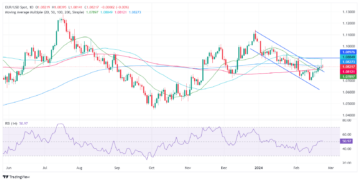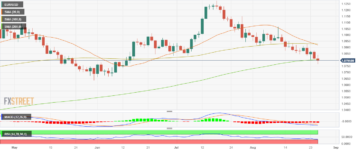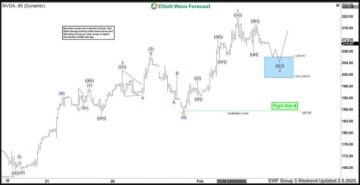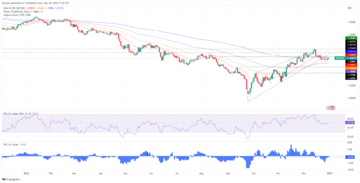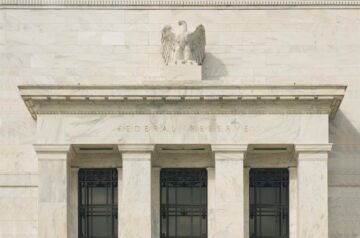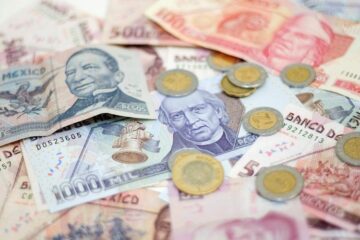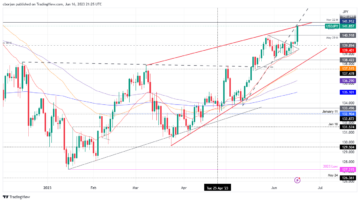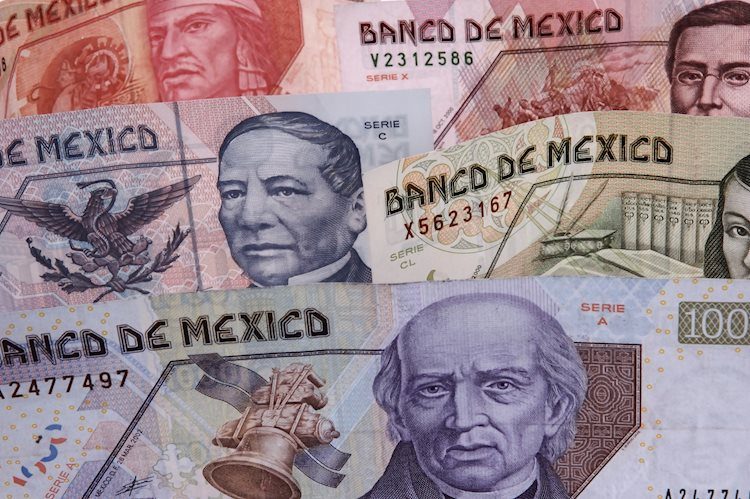
- Mexican Peso gained on Friday but printed more than 4% weekly losses.
- Mexico’s economic docket will feature inflation data in the next week.
- USD/MXN set to extend its gains after printing a new cycle high at around 18.48.
Mexican Peso (MXN) finished the week with solid gains vs. the US Dollar (USD) on Friday after the United States (US) economic docket featured the release of September’s Nonfarm Payrolls report, which crushed estimates and last month’s data. Although US bond yields edged up, they retreated afterward while traders brace for the “higher for longer” mantra but do not expect another rate hike, as seen by the CME Fed Watch Tool. The USD/MXN exchanges hands at 18.16, down 0.50% on Friday.
Recently, the USD/MXN aimed up on words from Cleveland’s Fed President Loretta Mester, who adopted a neutral-hawkish stance, though emphasized inflation remains too high. Aside from this, next week, September Mexico’s inflation data will be featured on its economic docket, which could dictate the Bank of Mexico’s (Banxico) next monetary policy decision. On the US front, inflation, unemployment claims, consumer sentiment, and Fed speakers would entertain USD/MXN traders.
Daily Digest Market Movers: Mexican Peso remained solid at around 18.16 despite Fed’s Mester comments
- Cleveland’s Fed President Loretta Mester: She stated inflation is too high and wants it back to 2% by the end of 2025. She said the job market is very strong, though it is getting less tight.
- Mester added she will decide what the Fed should do on rates at the next meeting.
- The US 10-year Treasury bond yield drops from a daily high of 4.88% to 4.78%, a headwind for the USD/MXN pair.
- US Nonfarm Payrolls for September came at 336K, exceeding forecasts of 170K, and crushed last month’s 227K (upwardly revised from 187K).
- The Unemployment Rate in the US stood at 3.8% above estimates but flat compared with August, while the Participation Rate stood at 62.8%.
- Average Hourly Earnings eased from 4.3% to 4.2% YoY.
- Auto Exports in Mexico rose 16% YoY in September, above the prior month’s 15.7%.
- Mexico’s September auto Production soared 24%, smashing August’s 2.8% growth.
- According to Reuters, “Rohan Patel, Tesla’s senior public policy and business development executive, in a post on the platform X, formerly Twitter, rejected a Mexican media report saying Tesla had canceled its plans and thanked local, state and federal officials.”
- The Mexican Stock Exchange continues to feel the effects of the government’s decision to change airport tariffs, while rumors of Tesla’s canceling its Giga factory plant spooked investors.
- A Citi Banamex poll showed economists estimate headline inflation at 4.70% and core at 5.09% for the year’s end.
- Analysts polled by Citi Banamex foresee the USD/MXN to end 2023 at 17.80, up from 17.60, and for 2024 at 18.86, up from 18.70 two weeks ago.
- On Wednesday, the IMF raised Mexico’s growth projection in 2023 from 2.6% to 3.2% and from 1.5% foreseen in July to 2.1% for 2024.
- Banxico’s September poll amongst economists reported that interest rates are expected to remain at 11.25% while inflation would dip to 4.66%.
- The same poll shows the exchange rate is set to finish at around 17.64, down from 17.75.
- Mexico’s S&P Global Manufacturing PMI for September came at 49.8, sliding to contractionary territory and below August’s 51.2, as the economy loses steam.
- The Bank of Mexico (Banxico) held rates at 11.25% in September and revised its inflation projections from 3.5% to 3.87% for 2024, above the central bank’s 3% target (plus or minus 1%).
- Banxico’s Government Board highlighted Mexico’s economic resilience and the strong labor market as the main drivers to keep inflation at the current interest rate level.
Technical Analysis: Mexican peso in choppy trading between 18.15/20
The daily chart shows that the Mexican Peso is set to extend its losses. The USD/MXN pair has hit a new cycle high at 18.48, putting into play a challenge of the psychological 18.50 figure, which could extend towards the April 2018 yearly low of 18.60. With those levels cleared, the next stop would be the March 24 high at 18.79, followed by the psychological 19.00 figure. Conversely, if USD/MXN drops below 18.25, that would exacerbate a drop toward the 18.10 area, followed by the 18.00 figure.
Fed FAQs
Monetary policy in the US is shaped by the Federal Reserve (Fed). The Fed has two mandates: to achieve price stability and foster full employment. Its primary tool to achieve these goals is by adjusting interest rates.
When prices are rising too quickly and inflation is above the Fed’s 2% target, it raises interest rates, increasing borrowing costs throughout the economy. This results in a stronger US Dollar (USD) as it makes the US a more attractive place for international investors to park their money.
When inflation falls below 2% or the Unemployment Rate is too high, the Fed may lower interest rates to encourage borrowing, which weighs on the Greenback.
The Federal Reserve (Fed) holds eight policy meetings a year, where the Federal Open Market Committee (FOMC) assesses economic conditions and makes monetary policy decisions.
The FOMC is attended by twelve Fed officials – the seven members of the Board of Governors, the president of the Federal Reserve Bank of New York, and four of the remaining eleven regional Reserve Bank presidents, who serve one-year terms on a rotating basis.
In extreme situations, the Federal Reserve may resort to a policy named Quantitative Easing (QE). QE is the process by which the Fed substantially increases the flow of credit in a stuck financial system.
It is a non-standard policy measure used during crises or when inflation is extremely low. It was the Fed’s weapon of choice during the Great Financial Crisis in 2008. It involves the Fed printing more Dollars and using them to buy high grade bonds from financial institutions. QE usually weakens the US Dollar.
Quantitative tightening (QT) is the reverse process of QE, whereby the Federal Reserve stops buying bonds from financial institutions and does not reinvest the principal from the bonds it holds maturing, to purchase new bonds. It is usually positive for the value of the US Dollar.
- SEO Powered Content & PR Distribution. Get Amplified Today.
- PlatoData.Network Vertical Generative Ai. Empower Yourself. Access Here.
- PlatoAiStream. Web3 Intelligence. Knowledge Amplified. Access Here.
- PlatoESG. Carbon, CleanTech, Energy, Environment, Solar, Waste Management. Access Here.
- PlatoHealth. Biotech and Clinical Trials Intelligence. Access Here.
- Source: https://www.fxstreet.com/news/mexican-peso-stumbles-to-a-seven-month-low-amidst-resilient-us-dollar-domestic-economic-strains-202310061538
- :has
- :is
- :not
- :where
- ][p
- $UP
- 1
- 10
- 11
- 15%
- 16
- 17
- 19
- 2%
- 2008
- 2018
- 2023
- 2024
- 2025
- 24
- 25
- 31
- 40
- 49
- 50
- 51
- 60
- 70
- 75
- 8
- 80
- a
- above
- Achieve
- added
- adjusting
- adopted
- After
- ago
- aimed
- airport
- Although
- amongst
- analysis
- and
- Animate
- Another
- April
- ARE
- AREA
- around
- AS
- aside
- assesses
- At
- attractive
- AUGUST
- auto
- back
- Bank
- basis
- BE
- below
- between
- board
- bond
- Bond yields
- Bonds
- Borrowing
- business
- business development
- but
- buy
- Buying
- by
- came
- canceled
- central
- challenge
- change
- Chart
- choice
- Citi
- claims
- CME
- committee
- compared
- conditions
- consecutive
- consumer
- consumer sentiment
- content
- continues
- conversely
- Core
- Costs
- could
- credit
- crises
- crisis
- Current
- cycle
- daily
- data
- decide
- decision
- decisions
- Despite
- Development
- dictate
- Digest
- Dip
- do
- does
- Dollar
- dollars
- down
- drivers
- Drop
- Drops
- during
- Earnings
- easing
- Economic
- Economic Conditions
- economists
- economy
- effects
- eight
- eleven
- emphasized
- employment
- encourage
- end
- ends
- entertain
- estimate
- estimates
- exacerbate
- exchange
- Exchange rate
- Exchanges
- executive
- expanded
- expect
- expected
- exports
- extend
- extreme
- extremely
- factory
- Falls
- FAQ
- Feature
- featured
- Fed
- fed watch
- Federal
- federal officials
- Federal Open Market Committee
- federal reserve
- Federal Reserve Bank
- Federal Reserve Bank of New York
- feel
- Figure
- financial
- financial crisis
- Financial institutions
- financial system
- finish
- flat
- flow
- followed
- FOMC
- For
- forecasts
- foresee
- formerly
- Foster
- four
- Fourth
- Friday
- from
- front
- full
- gained
- Gains
- getting
- Giga
- Global
- Goals
- Government
- grade
- great
- Greenback
- Growth
- had
- Hands
- headline
- Held
- High
- Highlighted
- Hike
- Hit
- holds
- HTTPS
- if
- IMF
- in
- Increases
- increasing
- inflation
- institutions
- interest
- INTEREST RATE
- Interest Rates
- International
- international investors
- into
- Investors
- involves
- IT
- ITS
- Job
- jpg
- July
- Keep
- labor
- labor market
- Last
- less
- Level
- levels
- local
- Loses
- loss
- losses
- Low
- lower
- Main
- MAKES
- mandates
- Mantra
- manufacturing
- March
- Market
- May..
- measure
- Media
- meeting
- meetings
- Members
- Mexico
- module
- Monetary
- Monetary Policy
- money
- more
- Movers
- Named
- New
- New York
- next
- next week
- Nonfarm
- Nonfarm Payrolls
- of
- officials
- on
- open
- or
- pair
- Park
- participation
- Payrolls
- Peso
- Place
- plans
- plant
- platform
- plato
- Plato Data Intelligence
- PlatoData
- Play
- plus
- pmi
- policy
- poll
- positive
- Post
- president
- Presidents
- price
- Prices
- primary
- Principal
- printing
- Prior
- process
- Production
- Projection
- projections
- public
- purchase
- Putting
- QE
- QT
- quantitative
- Quantitative Easing
- quickly
- raised
- raises
- Rate
- Rate Hike
- Rates
- regional
- reinvest
- Rejected..
- release
- remain
- remained
- remaining
- remains
- report
- Reported
- Reserve
- reserve bank
- resilience
- Resort
- Results
- Reuters
- reverse
- rising
- ROSE
- Rumors
- s
- S&P
- S&P Global
- Said
- same
- saying
- seen
- senior
- sentiment
- September
- serve
- set
- seven
- shaped
- she
- should
- showed
- Shows
- situations
- sliding
- soared
- solid
- speakers
- Stability
- stance
- starts
- State
- stated
- States
- Steam
- stock
- Stock Exchange
- Stop
- Stops
- strong
- stronger
- substantially
- system
- Target
- tariffs
- terms
- territory
- Tesla
- than
- that
- The
- the Fed
- their
- Them
- These
- they
- this
- those
- though?
- throughout
- tightening
- to
- too
- tool
- toward
- towards
- Traders
- Trading
- treasury
- two
- unemployment
- unemployment rate
- United
- United States
- us
- US bond yields
- US Dollar
- USD
- used
- using
- usually
- value
- very
- vs
- wants
- was
- Watch
- Wednesday
- week
- weekly
- Weeks
- weighs
- What
- when
- which
- while
- WHO
- will
- with
- words
- would
- X
- year
- yearly
- Yield
- yields
- york
- zephyrnet

